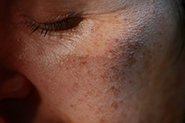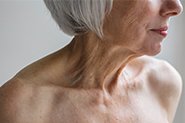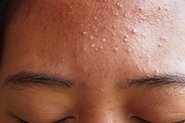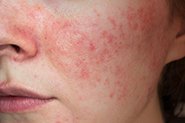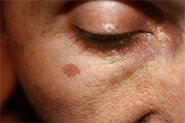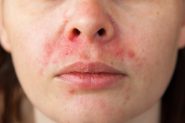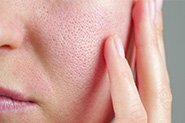
Slugging (putting an occlusive moisturiser like Vaseline over your normal moisturiser for extra hydration) regularly trends on social media. In this blog post Qr8 Founder and PhD scientist, Dr Michele investigates Vaseline (aka petrolatum), and its moisturising ability (and whether it is moisturising enough to use it alone!).
What is Petrolatum?
Petrolatum/petroleum jelly/white soft paraffin/ are all different names for the same thing, sold primarily under the brand names ‘Vaseline’ and ‘Aquaphor’.
Petrolatum is a safe, non-reactive and non-allergenic substance. The internet will try to scare you with falsehoods about its safety, but the kind of petrolatum used for cosmetic and personal use products, although derived from crude oil, is highly refined and purified.
Is Petrolatum a Moisturiser?
Petrolatum is most commonly known as an occlusive moisturiser. It forms a semi-permeable (‘breathable’) layer on the skin to reduce (not block) water evaporating into the atmosphere, something called Trans-Epidermal Water Loss, or TEWL, in both normal and irritated skin. This causes an increase in hydration in the outer layers of skin, fed from a plentiful supply in the dermis. By definition then, petrolatum is a moisturiser, as increasing skin hydration is what a moisturiser does1.
Petrolatum’s moisturising ability can be temporarily increased by applying a thin layer to damp, rather than dry, skin – but, as with water present in other skincare formulations, water applied topically to the skin via skincare products is lost to the atmosphere after 10-20 minutes2-4. Because petrolatum stays on skin for longer (something in cosmetic science known as ‘substantivity’), it continues to function as a moisturiser long after other moisturisers have evaporated from the skin4.
Petrolatum isn’t just an occlusive moisturiser, it is also an emollient. It moves into the spaces around skin cells within the stratum corneum to take the place of lost lipids in dry and/or damaged skin, immediately improving the skin’s barrier function1, as well as the skin’s smoothness and softness.
But that’s not all…
Along with physically reducing TEWL, immediately restoring barrier function, and softening and smoothing skin through its emollient function, petrolatum also triggers molecular changes within the skin to increase proteins that are an integral part of healthy skin structure (e.g. filaggrin, loricin), as well as enzymes that initiate the skin’s own barrier repair mechanisms. It also increases production of antimicrobial peptides to reduce infection. Long term application of petrolatum also drives skin cell turnover and increases stratum corneum thickness5,6.
This is why petrolatum is the most commonly used ingredient in skincare products worldwide, after water, and is also the standard against which all other moisturisers are compared in scientific studies1,7.
Does Petrolatum form an impenetrable barrier, and ‘suffocate’ the skin?
Petrolatum soothes irritation caused by dryness and skin barrier impairment via all the mechanisms listed above, not just by adding a physical layer on top of skin.
Although it reduces TEWL significantly more than any other occlusive (including lanolin, vegetable oils, shea butter and dimethicone) it still only provides a semi-permeable barrier because the hydrogen bonds in its molecular structure allow the passage of water. Petrolatum does not seal the skin like cling wrap or parafilm, both of which produce complete occlusion, which would prevent substances passing in either direction8,4, also shown in the diagram below:
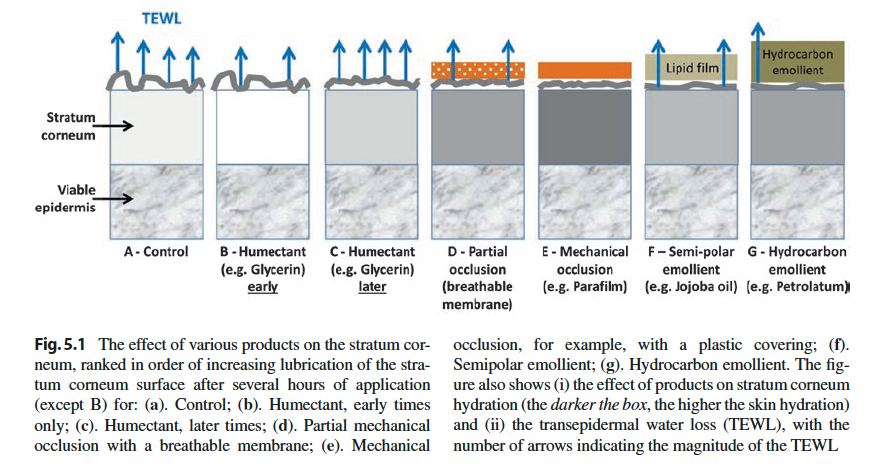
To further illustrate this, a study was performed where skin was dried out with pure acetone, followed by application of a waterproof film, and skin barrier repair was measured over time. The results showed that the skin barrier could not repair itself when an impermeable film was applied9. If petrolatum were truly a complete occlusive, it would also prevent skin barrier repair. Instead, it immediately improves the skin barrier and speeds up full restoration of barrier function, as well as triggering other changes in skin leading to barrier repair as previously discussed.
So petrolatum does not form an impermeable barrier – products applied over the top of it will also able to penetrate through it. Oh, and skin doesn’t ‘breathe’ anyway (that’s your lungs’ job), so it’s not possible to suffocate it!
Does Petrolatum clog pores?
Petrolatum is non-comedogenic (doesn’t clog pores or cause pimples) when tested in humans and on rabbit ears (the original method by which comedogenicity used to be measured scientifically)12.
But, applying too much can feel greasy and cosmetically inelegant, which is why a tiny amount is more than enough, especially when applied to damp skin. You can also apply it just to areas that need a bit of extra moisture, rather than your entire face.
Plain Language Summary:
The science shows that petrolatum (aka Vaseline) is an excellent barrier supportive moisturiser, particularly when using prescription-only topical drugs, as these dry out skin, and can cause irritation in the early stages. It is a matter of personal preference which moisturiser you use, but anything that we recommend is always on the basis of scientific evidence, along with our clinical experience with managing skin health and minimising side effects for thousands of our patients who use these topical drugs.
Read more about our Skin Barrier Support Service HERE
REFERENCES
- Ghadially R, Halkier-Sorensen L, Elias PM. Effects of petrolatum on stratum corneum structure and function. J Am Acad Dermatol. 1992. PMID: 1564142.
- Batt MD, Fairhurst E. Hydration of the stratum corneum. Int J Cosmet Sci. 1986. PMID: 19457222.
- Rawlings AV, Leyden JJ. (Eds). 2009. Skin Moisturization (2nd ed). CRC Press.
- Leite-Silva VR, Grice JE, et al. 2017. The Influence of Emollients on Dermal and Transdermal Drug Delivery. In: Dragicevic, NI, Maibach, H (eds) Percutaneous Penetration Enhancers Drug Penetration Into/Through the Skin. Springer, Berlin, Heidelberg.
- Danby SG, Draelos ZD, et al. Vehicles for atopic dermatitis therapies: more than just a placebo. J Dermatolog Treat. 2022. PMID: 32654550.
- Buraczewska I, Berne B, et al. Long-term treatment with moisturizers affects the mRNA levels of genes involved in keratinocyte differentiation and desquamation. Arch Dermatol Res. 2009. PMID: 18850104.
- Draelos ZD. Active agents in common skin care products. Plast Reconstr Surg. 2010. PMID: 20124857.
- Czarnowicki T, Malajian D, et al. Petrolatum: Barrier repair and antimicrobial responses underlying this “inert” moisturizer. J Allergy Clin Immunol. 2016. PMID: 26431582.
- Grubauer G, Elias PM, Feingold KR. Transepidermal water loss: the signal for recovery of barrier structure and function. J Lipid Res. 1989. PMID: 2723540.
- Sood A, Kogan S, Granick MS. 2018. Wound Dressings and Comparative Effectiveness Data. In: Shiffman M, Low M. (eds) Chronic Wounds, Wound Dressings and Wound Healing. Recent Clinical Techniques, Results, and Research in Wounds, vol 6. Springer, Cham.
WOULD YOU LIKE TO CHAT TO ONE OF OUR FRIENDLY DOCTORS ABOUT YOUR SKIN?
CLICK HERE TO BOOK A CONSULT WITH OUR EXPERIENCED MEDICAL TEAM.


